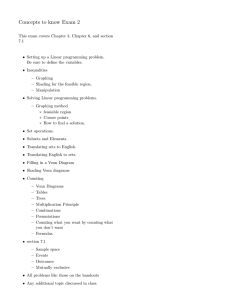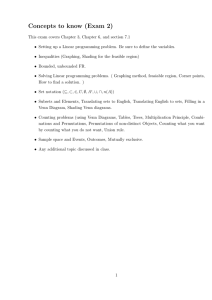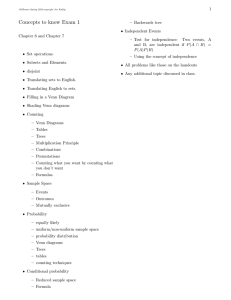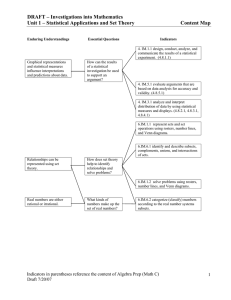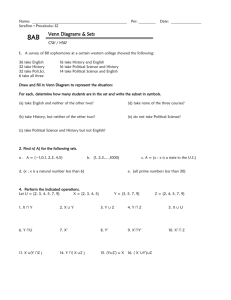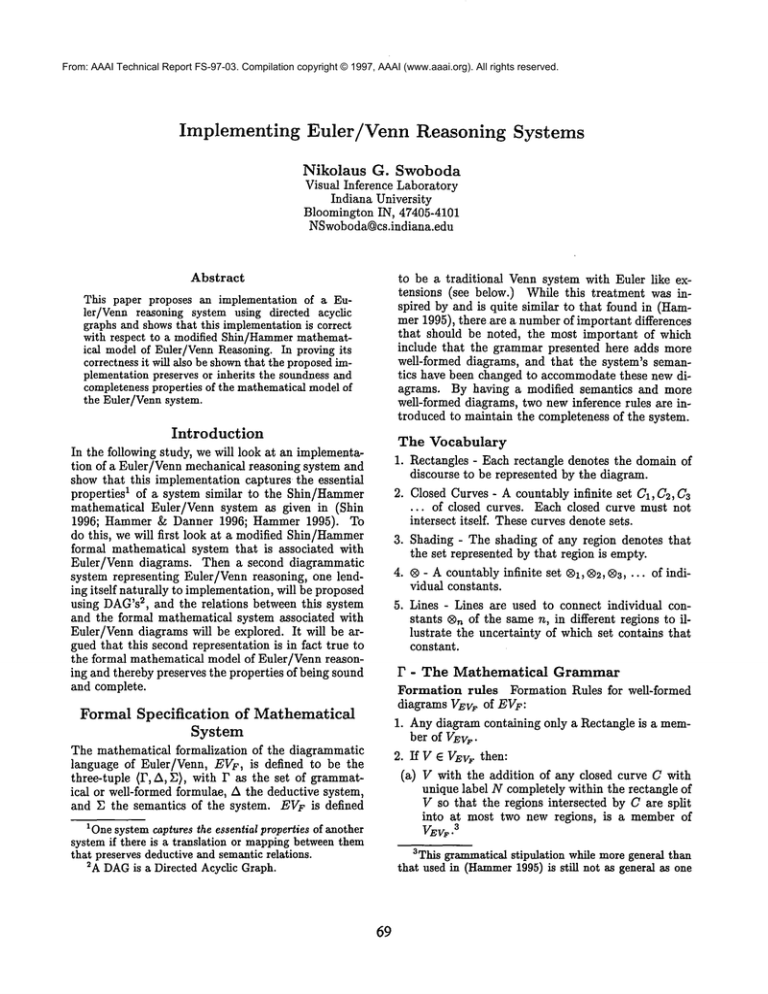
From: AAAI Technical Report FS-97-03. Compilation copyright © 1997, AAAI (www.aaai.org). All rights reserved.
Implementing
Euler/Venn
Reasoning
Systems
Nikolaus
G. Swoboda
Visual Inference Laboratory
Indiana University
Bloomington IN, 47405-4101
NSwoboda@cs.indiana.edu
Abstract
to be a traditional Venn system with Euler like extensions (see below.) While this treatment was inspired by and is quite similar to that found in (Hammer 1995), there are a number of important differences
that should be noted, the most important of which
include that the grammar presented here adds more
well-formed diagrams, and that the system’s semantics have been changed to accommodatethese new diagrams. By having a modified semantics and more
well-formed diagrams, two new inference rules are introduced to maintain the completeness of the system.
This paper proposes an implementation of a Euler/Venn reasoning system using directed acyclic
graphs and showsthat this implementationis correct
with respect to a modified Shin/Hammermathematical model of Euler/Venn Reasoning. In proving its
correctness it will also be shownthat the proposedimplementation preserves or inherits the soundnessand
completenessproperties of the mathematicalmodelof
the Euler/Venn system.
Introduction
In the following study, we will look at an implementation of a Euler/Venn mechanical reasoning system and
show that this implementation captures the essential
properties 1 of a system similar to the Shin/Hammer
mathematical Euler/Venn system as given in (Shin
1996; Hammer & Danner 1996; Hammer 1995). To
do this, we will first look at a modified Shin/Hammer
formal mathematical system that is associated with
Euler/Venn diagrams. Then a second diagrammatic
system representing Euler/Venn reasoning, one lending itself naturally to implementation, will be proposed
~, and the relations between this system
using DAG’s
and the formal mathematical system associated with
Euler/Venn diagrams will be explored. It will be argued that this second representation is in fact true to
the formal mathematical model of Euler/Venn reasoning and thereby preserves the properties of being sound
and complete.
Formal
Specification
of Mathematical
System
The mathematical formalization of the diagrammatic
language of Euler/Venn, EVE, is defined to be the
three-tuple (F, A, ~]), with F as the set of grammatical or well-formed formulae, A the deductive system,
and ~ the semantics of the system. EVE is defined
The Vocabulary
1. Rectangles - Each rectangle denotes the domain of
discourse to be represented by the diagram.
2. Closed Curves - A countably infinite set C1, C2, C3
... of closed curves. Each closed curve must not
intersect itself. These curves denote sets.
3. Shading - The shading of any region denotes that
the set represented by that region is empty.
4. ® - A countably infinite set ®1,®2,®3,... of individual constants.
5. Lines - Lines are used to connect individual constants ®n of the same n, in different regions to illustrate the uncertainty of which set contains that
constant.
F - The Mathematical
Grammar
Formation rules Formation Rules for well-formed
diagrams VEVFof EVF:
1. Any diagram containing only a Rectangle is a member of VEVF.
2. If V E VEVFthen:
(a) V with the addition of any closed curve C with
unique label N completely within the rectangle of
V so that the regions intersected by C are split
into at most two new regions, is a member of
vEv~.3
1Onesystemcaptures the essential properties of another
system if there is a translation or mappingbetween them
that preserves deductive and semantic relations.
2A DAGis a Directed Acyclic Graph.
3This grammatical stipulation while more general than
that used in (Hammer
1995) is still not as general as one
69
(b) V with the addition of a ®, of a new n within any
region of a closed curve of V is a memberof VEV~.
(c) V with the shading of any enclosed region is
member of VEVF.
(d) If V contains a certain ®n then the result of
adding another ®n to any region not containing
®, and then connecting the two of them together
with a line is a memberof VEVF.
lowing rules 4 to V:
1. Erasure of part of a ® sequence - V~ is obtained
by erasing a ®n of a ® sequence of V where that
®n falls within a shaded region and provided that
the possibly split ® sequence is rejoined by a line if
necessary.
2. Extending a ® sequence - V’ is the result of
adding a new ®n link to a ® sequence of V to a
minimal region not already containing a link of that
sequence.
3. No other diagram is in VEv~.
Examples of diagrarn~
of EVF
3. Erasure - V’ is obtained from V by erasing:
Valid
Diagram
~
v]
Invalid
Diagram
(a) An entire ® sequence
(b) The shading of a region
(c) A closed curve if the removal does not cause any
counterpart regions to disagree with regard to
shading or containment of links of a ® sequence
4. Introduction of a new curve - V~ is the result
of adding a new curve to V, so that the other labels
of V are left undisturbed and all counterparts agree
with respect to shading and containment of links of
a ® sequence.
+v
I
Notion of region A region is any area of a diagram
completely enclosed by lines of that diagram. Any region of the diagram completely enclosed by one closed
curve is referred to as a basic region. A minimal region
is any region which is not the combination of other regions. The following set theoretic operations on regions
will be allowed:
5. Inconsistency - V’ of any form can obtained from
V if V contains a region that is both shaded and has
the one and only link of a ® sequence.
1. U The union of two regions is the region containing
both of those regions.
2. N The intersection of two regions is the region that
is commonto both regions.
of
6. Adding shaded regions - W is the result
adding a new minimal region corresponding to the
intersection of basic regions already existing in V
provided that this new region is shaded and it drawn
so that the region is contained within the basic regions to whose intersection it is intended to correspond.
3. C One region is the subset of another if that region
is entirely contained within the other.
4. - The difference of two regions is the regions of the
first not contained by the second.
5. ~ The complementof a region is the region not contained in that region but still within the rectangle of
the diagram.
7. Removing shaded regions - W is the result of
removing a shaded minimal but not basic region of
V. To emphasize the fact that the region has been
removed the lines enclosing the now non-existing
region should be smoothed into curves, and the
remaining curves should be spaced out to remove
points of unintended intersection.
Notion of counterpart Tworegions of different diagrams are considered to be counterparts if both are
directly enclosed by rectangles or if there is a subset
of the labels of the diagrams such the regions are both
the result of taking the intersection of the basic regions associated with this set of labels. Counterparts
are preserved under union and complement. Counterparts agree with respect to shading and ® sequences in
two diagrams when for any two regions that are counterparts one is shaded iff the other is shaded, and one
contains a link of a ®n sequence iff the other contains
a ®n link of the same n.
A - The Mathematical
Deductive
Unification - Wcan be inferred from diagrams V1
and I/2 if it is the case that:
1. The set of labels of V~ is the union of the labels of
V1 and½.
2. Counterparts in both Wand V1 and Wand Vg. agree
with respect to shading and containment of a link of
a ® Sequence.
System
The following are figures to illustrate
system’s two new rules.
Given diagrams V and W of EVF, W can be inferred
from V if Wis the result of applying any of the fol-
the use of the
4please
notethattherulesof Adding
shaded
regions
and Removing
shadedregionsarethe abovementioned
newrules.
might like. But it can be argued that any valid Euler/Venn
Diagramcan be expressed under this restriction.
7O
1. If V’ is the result of applying the rule of Adding
a Shaded Region to V, then V ~EV~ V’. Suppose that (U, I) ~Ewr V then for all minimal regions r not existing in V I(r) = ~. Thus since the
newly added region is shaded then I(r) = 0, and
Adding Shaded Regions:
(u, I) ~Ev~
y’.
2. If Wis the result of applying the rule of Removing
a Shaded Region to V, then V ~EWFW. Suppose
that (U, I) ~EVFV then for all shaded regions r in
diagram I(r) = ~. Thus since the removed minimal
region does not exist in the diagram then I(r) =
and (U, I) ~Evv V’.
Theorem 2 Completeness
of EVF (Extension
of
Hammer (Hammer 1995))
For every set of diagrams ~ U {V}, if !U ~EVFV then
~B FEwFV.
RemovingShaded Regions:
A diagram V is provable from the set of diagrams !U
in EVE, written as fi7 ~-EFv V, if there is a sequence
of diagrams V1... Vn where Vn is equal to V and all
V1 ... Vn are either membersof fi7 or the result of applying one of the above rules of inference to a prior
diagram in the sequence.
Proof Sketch:
For this proof, Hammer’scompleteness proof found in
(Hammer1995) will again be greatly relied upon. First
all diagrams in !U are extended to Venn diagrams and
put into the set flY, through the repeated application of
the Adding shaded regions inference rule. The same
is done to V extending it to V’. From soundness and
the transitivity of ~Eveit is concluded that !U’ ~Ew~
W. NowHammer’scompleteness result will be used to
show that ~U’ t-~wF V’. Wenow only need to apply the
rule of Removing shaded regions to show V’ ~-EWF
V. Hence !U t-EWF V.
To further clarify the above proof the following diagram has been provided.
- The Mathematical
Semantics
The semantics of the systemis given by the assignment
of a domain to the diagram and subsets of this domain
to each basic regions of the diagram. Formally this
assignment is the pair (U, f) where U is the domainand
f is a function associating a subset of U with each basic
region. Basic regions of the same label are assigned the
same subset of U by f.
Proposition 1 (Hammer (Hammer 1995))
If (U, f) is an assignment of U to basic regions then
there is a unique set assignment (U, g) to minimal regions(where g is a function assigning subsets of U to
the minimal regions of the diagram with minimal regions not existing in the diagram being assigned 0).
Given this (U, g) and (U, f), there is a unique model
(U,I) s.t. it extends both of them. This model’s interpretation function I preserves the counterpart relation.
Formal Specifications of the DAG
Implementation
Diagram V is true in model M = (U, I) of EVF iff
for every region r of V, if r is shadedthen I(r) = O, and
if r completely contains a ® sequence then I(r) ~
Whenthis is the case M~EVFV will be written. With
~Ttl {V}a set of diagrams, V is a logical consequenceof
in EVe iff every modelwhich makes all of ~7 true in
EVFalso makes V true. This is written as ~ ~Ev~ V.
Soundness
and
Completeness
The implementation of the diagrammatic language of
Euler/Venn, EVI, is defined to be the three-tuple
(#,z),s).
The Vocabulary
of the Implementation
Nodes
Each
node
represents a set that can be ex1.
pressed as the intersection of one or more of the sets
represented by the diagram. Associated with each
node are a number of attributes:
a name, whether
the set is empty (shading), and whether the set possibly contains any individual constants (®,). Regions are namedso that the set that they represent
is exactly the intersection of the sets associated with
the letters of its name. Likewise a node can also be
thought of as a region, not necessarily minimal, of
the diagram.
of EVE
Theorem 1 Soundness of EVF (Extension
of Hammer (Hammer 1995))
For every set of diagrams ~ U {V}, if ~ FSVFV then
~Ev~V.
Proof Sketch:
It suffices to show that the two new rules of inference preserve soundness; this plus Hammer’sSoundhesS proof will demonstrate the soundness of EVF.
71
2. Directed Edges - Directed edges connect nodes A
and B, leading from A to B, expressing that their
associated sets, S(A) and S(B), are such that S(A)
covers5 S(B). Likewise the edge relation can also be
thought of in terms of region containment.
1. Erasure of part of a ® sequence - D’ is obtained
by removing a ®n of a ® sequence from a minimal
region provided that this minimal region is shaded.
The ®n is also removedfrom its ancestors not having
a different descendent also containing a ®, of the
same n.
In the sections to follow the natural meaning of the
predicates parent, child, ancestor, and descendent will
be used.
.
G - The Grammar of the Implementation
Formation Rules for proper DAG’sDEv~of EVI:
1. Any DAGcontaining only one node named V and
no edges is a memberof DEv,.
.
Erasure - D’ is obtained from D by erasing:
® sequence, removing all ®n’s of a certain n occuring in any node of the DAG.
(b) The shading of a minimal region, and the shading
of any of its parents not having all shaded descendants.
(c) A basic region and all regions containing that region’s identifying letter or its complement, provided that the removal does not cause any counterpart regions to disagree with regard to shading
or containment of links of a ® sequence.
(a) N is connected to at least one other node N’, and
does not cause a cycle in the DAG.
(b) N’s name contains all of the letters of the names
of its parents with at most one additional letter.
(c) N’s name does not contain, for any letter L, L
and L.
is memberof DEv,.
.
3. If D 6 DEv,, then the modification of D such that
either:
(a) Somenode along with all of its descendents are
shaded.
(b) Someterminal node and all of its ancestors contain
a ®n.
.
is memberof DEv,.
.
4. No other DAGis a member of DEv,.
Notion of region A region is represented by a node
of the DAG.A region is referred to as a basic region if
its label contains a letter with no bar, not contained in
the labels of any of its parents. This letter is referred
to as the basic region’s identifying letter. A minimal
region is any terminal node of the DAG.As before the
set theoretic operations U, N, C, -, ~ will be allowed
.
on regions.
Introduction of a new curve - D’ is the’result
of adding a new basic region to D as specified by
the Inductive Construction Technique (defined below) and the other labels of D are left undisturbed
and all counterparts agree with respect to shading
and containment of links of a ® sequence.
Inconsistency
- Any D’ can be obtained from D
if D contains a minimal region that is both shaded
and has the one and only link of a ® sequence.
Adding shaded regions - D’ is the result of
adding a new minimal region not existing in D as
specified by the Direct Construction Technique (defined below) and provided that this minimal region
is shaded and is not a basic region.
Removingshaded regions - D’ is the result of removinga minimal but not basic region that is shaded
from D and re-arranging the DAGas specified by
step 4 of the Direct Construction Technique.
Uu~flcation - D’ can be inferred
and Dg. if it is the case that:
Notion of counterpart Two regions are considered
to be counterparts if both of their names contain the
same set of letters. Counterparts are once again preserved under union and complement.
System
result of
D in a minof that sethat node’s
(a) An entire
2. If D 6 DEvl, then D with the addition of one new
node N such that:
79 - The Deductive
Implementation
Extending a ® sequence - D’ is the
adding a new ®n link to a ® sequence of
imal region not already containing a link
quence. The same link is added to all of
ancestors.
from DAG’sD1
1. The set of basic regions of D’ is the union of the
basic regions of D1 and D2.
2. Counterparts in both D’ and D1 and D’ and Dg.
agree with respect to shading and containment of a
link of a ® sequence.
of the
A DAGD is provable from the set of DAG’s ~,
written aa ~ I-EvI D, if there is a sequence of DAG’s
D1...D, where Dn is equal to D and all D1...D,
are either membersof ~ or the result of applying one
of the above rules of inference to a prior DAGin that
sequence.
Given DAG’sD and D’ ofEVi, D’ can be inferred from
D if it is the case that D’ is the result of applying any
of the following rules to D.
5,,A covers B" itf B ~ A and there is no C such that
B~CandC~A.
72
S - The Semantics
of the
Implementation
directly below Y and X with an edge from Y to
YA ~
and from X to XA.
(b) Identify all regions represented by nodes in the
DAGcrossed by YA and X-A (previously known as
A and A respectively.) s For each of these crossed
regions W, add to D~ WYAand WXAwith edges
from W to each of them and_edges from YA to
WYA and from XA to WXA. Then any duplicate letters that might occur in an individual name
are removed.
(c) Starting with the top of the DAG,determine if
any region is now covered by or covers one of the
newly created regions Z, all regions whose name
contains A or A. Assume that it is W that now
covers Z. Removethe edge leading to Wfrom its
previously covering parent connect this old parent
to Z and draw a new edge from Z to W.9 Appropriately rename each of these nodes Wto include
the letter(s) of their new parent Z not previously
in W. After doing this the new letters are added
to each of W’s descendents, also adding new edges
to their possible new parents. This is done to retain only edges between covering regions.
The semantics of the system is given by the assignment of a domain to the root of the DAG,and subsets
of this domain to each basic region of the DAG.Formally this assignment is the pair (U, f), U being the
domain and f being a function associating with each
basic node a subset of U. Nodes of the same identifying letter are assigned the same subset of U. Non-basic
regions not existing in the DAGare assigned 9 by f.
Onceagain Proposition 1 is used to establish that given
(U, f) there is a unique assignment to minimal regions
(U, g) and a unique model (U, I) extending them both.
Diagram D is true in model M= (U, I) of EVI iff
for every region r of D, if r is shaded then I(r) =
and if r or its descendants contain an entire ® sequence
then I(r) ¢ 9. Whenthis is the case M~Ev~D will be
written. With ~ (9 {D}a set of diagrams, D is a logical
consequence of ~ in EVI iff it is true in every model
which makes all of ~ true in EVI. This is written as
~sy, D.
Relationships
Relationship
Between
Between
(F,
A, ~) and
3. Final Step - To finish the construction shading and
® sequence information needs to be included. Shade
all minimal regions of the DAGwhich correspond to
shaded minimal regions of the diagram. Likewise
add a ®n to a minimal region of the DAGif its
corresponding region of the diagram has a link of
a ® sequence of a certain n. Then starting at the
bottom of the DAGand working up shade any node
having all shaded children and put an @ninto any
node having any children with a ®~of a certain n.
P and
This section explains the grammatical relation between the formal mathematical representation of a Euler/Venn diagram and its corresponding DAG.It will
be shown that there is a translation process that results in a bijection between classes of isomorphic Euler/Venn Diagrams and DAG’s. This translation process will be given in two forms one inductive and the
other direct. Each method is needed to explain algorithms used in the deductive system of the implementation(namely the rules of Introduction of a new
curve, Adding shaded regions,
and Removing
shaded regions.)
Example of inductive
construction
1. The empty diagram.
Translating
Euler/Venn diagrams into DAG’s,
inductive
construction
Knowing that an Euler/Venn Diagram V can be constructed by a sequence
of adding circles in a certain way to an empty diagram, it suffices to define the translation technique in6ductively on this sequence.
V
®
1. Base - The empty diagram is the DAGwith one node
V and no edges.
2. Induction - Whenadding circle A to an existing Euler/Venn diagram V~ ~
and its corresponding DAGD
proceed as follows:
2. After adding the set A.
(a) Identify the region Y that covers A and the region
X that covers A. Add nodes YA and XA ~
to D
vIn the case that Y is V leave out the V from the names
of the nodes to makeour DAG’seasier to read.
SFromthe grammarI ~ it is knownthat each of these
regions is crossed once creating two newml,lrnal regions.
9Heresince it is knownthat there is a unique covering
parent so at most one edge needs to be changed for each
node.
eIf given an already constructed Euler/Venn Diagram
this sequence can be arbitrarily chosen. The order of the
placementof the circles on the page makesno difference as
long as the two resulting diagram.qare equivalent.
73
v
©
Figure 1: Example of rule 3. for one minimal node
3. After adding the set B. B and B are added below
V and both A and A are split.
and concatenating the appropriate letter to its current name. Finally to make the names easier to read
alphabetize the letters of the name.
2. Start by adding to an empty DAGone node appropriately named for each minimal region of the Euler/Venn diagram V.
3. Let N be the number of sets in the Euler/Venn diagram, thus the name of each of the minimal nodes
consists of exactly N letters, n For each of these
minimal nodes add to the diagram as their parents
nodes with names consisting of N choose N - 1,
sometimes written as (NN_I), letters from each
their names, while being careful not to duplicate any
node. Thus for each minimal region with a name of
N letters construct parents for that node all of which
have names of length N - 1 and are subsets of the
nameof the minimal region. (See Figure 1 for further
clarity.) If a duplicate occurs connect that minimal
region to the already existing node. Continue this
process for each of the nodes of N - 1 letters and
so on, until only nodes consisting of one letter are
added. Finally add the node V as the parent of each
of these nodes consisting on only one letter.
m
4. After adding th_.e set C. C is added below A and
renamed AC, C is added below V. B, A, B,_AB,
and AB are split.
Duplicates AC, ABC, and ABC
are removed.
5. Re-order, A becomes AC, AB becomes ABC, AB
becomes ABC, BC becomes ABC, and BC becomes A BC. Edges from C to A B C and from B to
ABUare removed and a_ppropriatel_y replaced. Finally remove duplicates ABC and ABC.
4. Starting with the minimal nodes and working up the
DAG,eliminate all nodes who only have one child,
and following this delete any nodes with no descendent minima/regions. If a node only has one child it
is the union of one region thus equal to its child, and
if it has no descendent minimal regions it is null.
5. Lastly shade and add ®,’s to the minimal nodes of
the DAGand then the entire DAGas done in the
last step of the Inductive Construction.
Translating
Euler/Venn diagrams into DAG’s,
direct construction
Given any Euler/Venn diagramV do the following to translate it into a corre1°
sponding DAGD:
Example of direct
1. First identify all minimal regions of the Euler/Venn
Diagram V. To each of these regions associate a
name which contains the letters of all of the sets
of the diagram or their complements. Thus for any
minimal region R start by naming the region A (the
emptystring) and iteratively look at each of the sets
represented in the diagram asking whether the minimal region is a subset of that set or its complement
.
construction
After first two steps, a partial DAGwith only mlnireal regions.
llEach rnlnlrnal region has a nameof length N from part
1. of the current construction.
10
Note, the intermediate DAG
s used in this construction
maynot be well-formed in terms of the above grammarG.
74
2. After first iteration
of step 3, adding nodes
{AB, BC, AC, AB, BC, AC, A C, A B, BC, B C, AB}
3. After second iteration
3. Twointersecting sets:
of step 3, adding nodes
{C,B,A,A,B,C}.
4. Three intersecting sets:
4. After third iteration of step 3, adding node {V}.
5. A set completely contained in another:
5. Final
dialgam after
{AB,BC,BC,C,A}.
step 4, removing nodes
Examples of well-formed
translations
diagrams
The Capturing of Essential
Properties
Lemma 1 Any Euler/Venn Diagram V can be translated into at least one DAG D.
and their
This is direct from either of the above construction
techniques.
1. The empty diagram:
Lernma 2 Any Euler/Venn Diagram V can be translated into a unique DA G D.
@
Proof Sketch:
First we notice that the regions of a Euler/Venn diagram can be ordered using the subset relation into a
partial order. Also any partial order or poset can be
described uniquely up to isomorphism by its comprising covers relations. Wethen shade the nodes of the
poser if that region is empty and put a ®n in the node
if it contains a link of the ® sequence of the same n. We
now have that for ~ach Euler/Venn diagram there is a
unique characterizing
poser. By above Lemma1 and
looking closely at the above construction technique it
is seen that the DAGbeing constructing is, with the
directed edges interpreted as spatial relations, just this
poser. This can be showninductively, focusing on the
inductive construction technique. For the base case
we look at the empty diagram, this has by definition
2. The diagram with one set:
V
75
a unique DAG. Assume Euler/Venn Diagram V has
a unique DAGand show that V with the addition of
one set has exactly one new node for each new region
and that the edge relation preserves the covers ordering. Here by rule 2(a) two nodes are added, one for
the new circle and another for its complement,so that
there are at least two new regions one corresponding to
the new set and the other to its negation. Due to the
grammar, each region crossed by the new set is divided
into two new regions, and by rule 2(b) exactly those
nodes are added to the DAG.Hence exactly the right
number of nodes are being added. Finally by rule 2(c)
the new DAGis re-ordered to preserve the covering
ordering. Trivially it is noted that the DAGand the
diagram both have the same nodes shaded and containing a links of a ® sequences, since the same rules
are used to shade the poser and the DAG.Thus for
all Euler/Venn diagrams our translation results in a
unique DAG.
Proof:
Given ~ I-~v, D we know that T-I(~) ~-EVF T-I(D)
from Theorem 3. From this it is concluded that
T-I(~) ~EVF T-I(D) from the soundness of EVF.
Lastly, again using Theorem 3, ~ ~Evz D is concluded. ¯
Theorem 5 Completeness
For every set of diagrams ~ U D, if ~ ~Evz D then
F Evl D.
Proof:
Given ~ ~gvz D we know that T-I(~) ~EVF T-l(D)
from Theorem 3. From this it is concluded that
T-I(~) FEVF T-I(D) from the completeness of EVF.
Lastly, again using Theorem3, ~ FEVzD is concluded.
Future Directions
In future work, it will be shownthat thinking of Euler/Venn diagrams as DAG’sallows one to more easily
define classes of Euler/Venn diagrams and algorithms
for determining membership in these classes. A few
such classifications are the class of Euler/Venn diagrams that do not have any intersecting regions, only
containment sometimes called transition diagrams, and
the class of Enler/Venn diagrams that can be drawn
as a valid Euler/Venn diagrams without any shading.
Lemma3 Each DAGD is the translation of a unique
class of isomorphic Euler/Venn diagrams.
Proof Sketch:
First we observe that each DAGhas a unique set of
terminal nodes with shading and ® information corresponding to the minimal regions of the diagram. We
next realize that each class of isomorphic Euler/Venn
diagrams is characterized by a unique set of minimal
regions with shading and ® information. 12 Hence any
DAGis the translation of a unique class of isomorphic
Euler/Venn diagrams.
Acknowledgments
I would like to thank Jon Barwise, Gerald Allwein,
Eric Hammer,Kathi Fisler, and the other members of
the Indiana University Visual Inference Lab for their
patience and help with this work. Special thanks
also goes to the US Dept. of Education whose Grant
# P200A502367provided support for this research.
Lemma4 The translation of a single Euler/Venn diagraminto its corresponding DAG by the inductive and
non-inductive techniques stated above results in two
equivalent DAG’s.
Theorem 3 For any set of Euler/Venn diagrams {fifU
V} C DEvF,there exists a unique corresponding set of
DAG’s T({fi7 O V}) C DEv, such that: !U t-EVF V
iff T(~U) FEe, T(V) m ~EVFV iff T( fi~) ~Ev,
References
Allwein, G., and Barwise, J., eds. 1996. Logical Reasoning with Diagrams. Oxford.
Hammer, E., and Danner, N. 1996. Towards a model
theory of Venn diagrams. In Allwein and Barwise
(1996). 109-127.
Hammer, E. M. 1995. Logic and Visual Information.
CSLI and FOLLI.
Shin, S.-J. 1996. Situation-theoretic account of valid
reasoning with Venn diagrams. In Allwein and Barwise (1996). 81-108.
T(V).
The proof of this theorem uses the above Lemma2
and Lemma3 and then demonstrates the close relationship between the deductive and semantic systems
of EVF and EVI.
Soundness
and Completeness
of EV}
Theorem 4 Soundness
For every set of diagrams ~ U D, if ~D FEV~D then
~EV, D.
12Thiscan be seen fromthe fact that all of the diagram.¢
in one isomorphismclass can be shownto be equivalent
to a Venn diagram with the shading of certain minimal
regions and with ®,%in certain minimalregions. Thus it
is by either the shadedor unshadedregions, since one is
the complementof the other, and which minimal l:egious
contain ®~’sthat the class is characterized.
76

